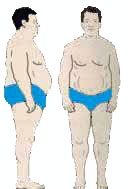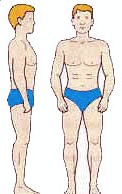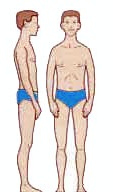

It is all in the shape
Brian Mackenzie explains the three body types - Endomorph, Mesomorph, and Ectomorph.
Our success as an athlete comes from a combination of athletic ability and our body build. There are three components to body build: type, size, and composition.
Body Type
There are three extremes of body types.
 |
Endomorph
|
 |
Mesomorph
|
 |
Ectomorph
|
Somatotyping
All athletes are made up of the three extreme body types, so we are all part endomorph, part mesomorph, and part ectomorph. Using a score of one to seven, we can grade our bodies on each of the extreme body types. For example, two, six, three means: two (low endomorphy); six (high mesomorphy); three (low ectomorphy). In this way, we can compare our body type with that of other athletes. This method of body typing is known as somatotyping. Height is not taken into consideration when working out our body type.
Body Size
Body size refers to the athlete's height and weight. The ideal size for an athlete depends on the sport or event and sometimes the position they play in their sport (consider the various body sizes in a Rugby team). There are standard ideal weight charts based on an individual's height. These tables, unfortunately, do not help athletes because they do not allow for body composition. Being overweight is not a problem provided it is the extra muscle and not fat.
Body Composition
Body composition refers to the athlete's body fat. In most sports, the athlete will try to keep their levels of body fat to a minimum. In general, the higher the percentage of body fat, the lower the performance.
Reference Man and Woman
The concept of a reference man and woman was developed in the 1960s by Dr Albert Behnke. The reference standard does not mean that men and women should try to achieve the body composition values, or that reference values represent "average". The model provides a useful reference to interpret the statistical comparison of athletes involved in physical training programs.
| Man | Woman | |
| Age | 20 to 24 | 20 to 24 |
| Height | 174 cm | 163.8 cm |
| Body Mass | 70.0 kg | 56.7 kg |
| Lean Mass | 61.7 kg | 48.2 kg |
| Muscle | 31.3 kg | 20.4 kg |
| Bone | 10.4 kg | 6.8 kg |
| Total Body Fat | 10.5 kg | 15.3 kg |
| Essential Fat | 2.1kg | 12.0 kg |
Article Reference
This article first appeared in:
- MACKENZIE, B. (2003) It is all in the shape. Brian Mackenzie's Successful Coaching, (ISSN 1745-7513/ 6 / October), p. 9
Page Reference
If you quote information from this page in your work, then the reference for this page is:
- MACKENZIE, B. (2003) It is all in the shape [WWW] Available from: https://www.brianmac.co.uk/articles/scni6a7.htm [Accessed
About the Author
Brian Mackenzie was a British Athletics level 4 performance coach and a coach tutor/assessor. He has been coaching sprint, middle-distance, and combined event athletes for the past 30+ years and has 45+ years of experience as an endurance athlete.